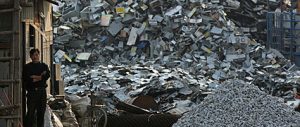Mercury pollution is a global issue with China at its centre. The United Nations Environment Programme (UNEP) is pushing hard to bring the problem under control and, by 2013, aims to put in place an international, legally binding deal. This would require all countries that release a certain amount of the heavy-metal into the environment to set reduction targets.
As China accounts for 25% or more of the world’s mercury emissions, it is under great pressure to make cuts. But the mission is proving a struggle.
Mercury is used in a wide range of industries in China, a point flagged up by the country’s Ministry of Environmental Protection (MEP) in technical guidelines for a national survey of mercury sources. UNEP lists 50 mercury sources across 11 different categories, and 40 of these exist in China. But there is still a lack of clarity on key issues: the quantity and distribution of these sources, the amounts of mercury being used and discarded, the quantity and handling of waste mercury and the extent of pollution.
Gu Mingxing, deputy director of the China Nonferrous Metals Industry Association, has taken part in two rounds of UNEP’s mercury negotiations. With less than a year to go before the final round of talks, Gu is worried about the expectations being placed on China: he does not believe the country will be able to produce a clear schedule for cutting mercury use in the required time. The demand from down-stream industries, particularly from healthcare and the chlor-alkali sector is simply too high, he said. In addition, 60% of manmade mercury emissions come from coal burning – likely to stay China’s main fuel for electricity generation for decades to come.
The chlor-alkali industry produces hydrogen, chlorine and sodium hydroxide, the building blocks of countless everyday products, including PVC. Sixty-three percent of China’s PVC production comes from a process that uses calcium carbide as feedstock. This process absorbs 7,000 tonnes of mercury catalyst, 770 tonnes of mercuric chloride and 570 tonnes of straight mercury each year. Calcium-carbide PVC production accounts for at least half of China’s total mercury use, making it the largest mercury consumer not just in China, but the world.
The 12th Five Year Plan (FYP) for the chlor-alkali industry includes production of 10 million tonnes of PVC using this method in 2012. To produce this amount, 12,000 tonnes of mercury catalyst and 1,000 tonnes of mercury are expected to be needed. However, the same plan also stresses the development and application of low-mercury catalysts.
The health sector is another key consumer of mercury. Here, the most common uses are in blood-pressure monitoring devices, thermometers and oesophageal dilators. Dental fillings and some dental instruments also use the heavy-metal. This industry uses an average of 200 tonnes of mercury or more every year, according to an employee at the China Association for the Medical Devices Industry.
The most common everyday use of mercury is in fluorescent lighting. One billion mercury-containing lights were discarded in 2006. Assuming these were all standard, 40-watt fluorescent bulbs, the mercury released into the environment due to improper disposal is likely to have reached 70 to 80 tonnes.
Restrictions on mercury are inevitable: China can do nothing to avoid them. UNEP’s 2011 talks in Chiba, Japan, included a proposal for a global ban on mercury by 2020. Meanwhile, individual regions and countries have been taking their own steps.
Europe already has an EU Mercury Strategy, designed to control mercury pollution. In March last year, a European Union ban on the export of metallic mercury, mercury ore, mercury compounds and alloys came into effect, as well a requirement for recycled mercury to be handled as waste rather than reused in industrial applications.
Meanwhile, the United States listed mercury as a harmful atmospheric pollutant in 1990. Since 2005, it has introduced laws requiring special handling of mercury products and waste; restricted emissions of mercury into the air and water; and regulated the use and emission of mercury by the coal-burning power and battery-making sectors. From 2013, the United States will ban the export, sale, distribution and transfer of metallic mercury.
China has also been hard at work. Before the first round of UNEP negotiations in 2010, the State Council approved a document on better prevention of heavy-metal pollution put together by the MEP and the Ministry of Industry and Information Technology (MIIT). That document set a target of bringing heavy-metal pollution – including mercury – under control by 2015.
In June 2010, the MIIT published a programme for tackling mercury pollution from PVC manufacturing. Broad aims include developing new, mercury-free catalysts and working towards the elimination of mercury from calcium-carbide based PVC manufacturing. Specific targets were also put forward, including using low-mercury catalysts in half of all cases by 2012 and across the board by 2015; cutting mercury use per tonne of PVC by 50% by 2015; and recycling all low-mercury catalysts by the same year.
In August 2010, at a summit in Xinjiang, the China Petroleum and Chemical Industry Federation put forward a three-stage plan: a phase of low-mercury use from 2010 to 2015, followed by a stage where mercury in liquid forms is eliminated from 2015 to 2020 and, finally, from 2021 onwards, no mercury use at all.
But many industry insiders are uncomfortable with that timetable and play it down. An employee at China Chlor-Alkali Industry Association said: “These are just targets for controlling mercury pollution; you can’t call it a schedule. We’re working hard to implement low-mercury catalyst technology, but the basic research hasn’t been done – the basic data isn’t clear and there’s a lack of financially viable replacements and technology. It’s not right to talk about a timetable.”
Some medics also worry about money, even complaining that World Health Organization’s Mercury-Free Healthcare initiative is a rich-world luxury. The WHO wants to eliminate the use of mercury in healthcare globally, and aims to cut the number of mercury thermometers and blood pressure monitoring devices by 70% by 2017. But a WHO official based in China was not optimistic about its chances: the cost of going mercury-free is simply too high, he said.
The State Environmental Protection Agency (now the MEP) and the US Environmental Protection Agency ran a mercury-free healthcare trial in China in 2006. Beijing’s Jishuitan Hospital and Ditan Hospital signed up, aiming to cut the number of mercury-containing devices by 30%. The efforts of China’s NGOs are also noteworthy. Beijing Global Village has long been researching mercury pollution and runs “mercury clean-up” activities in a number of cities.
But the Ministry of Health hasn’t imposed mandatory replacement of mercury-based devices. A glance at the comparative costs tells you why: a traditional mercury thermometer costs one or two yuan, while an electronic thermometer costs about 100 yuan. An old-style blood-pressure monitoring device costs a little over 100 yuan, while its mercury-free replacement carries a 1,700 yuan price tag. “Mercury-free healthcare is all very well, but we can’t afford it,” said one doctor at Beijing’s Jishuitan Hospital. “The hospital has to cover the costs – there’s no extra profit. We just pay the price of being socially responsible.”
A Ministry of Health official, who asked to stay anonymous, echoed these comments: “You can’t do away with mercury thermometers. The mercury-free replacements are too expensive; it’s not realistic to use them widely in China. And what about rural areas? What’s more important – people’s immediate health or controlling mercury?”
And so it looks highly likely that, in order to leave room for manoeuvre, mercury restrictions in China will be voluntary.
Feng Xinbin, deputy director of the State Key Laboratory of Environmental Geochemistry, pointed out that UNEP’s mercury negotiations don’t just affect the environment, but also China’s economic development. A historical perspective is essential, he said: “The west has emitted 200,000 tonnes of mercury over the last century, while China has released almost none. Even if we are releasing 600 tonnes a year now, that’s still nothing compared with their 200,000 tonnes. A huge amount of present day mercury pollution is historic in origin.”
In this context, Chinese industry has repeatedly stated the urgency and necessity of technology transfer, arguing that western nations need to cooperate with China’s efforts to eliminate the use of mercury in industry by providing technology free of charge.
“There still isn’t any written agreement on any of the content or targets for the mercury treaty,” explained one Chinese participant in the Chiba talks. “The developed nations are concerned about protecting the environment, while the emerging nations are more focused on economic development.
“If the European Union and United States don’t provide financial and technical support for the extraction and production of mercury, and for control of emissions, it is unlikely that China will be able to go mercury-free in the next 20 years.”
Tan Siying is a Beijing-based freelance journalist.
This article is published as part of our Green Growth project, a collaboration between chinadialogue and The Energy Foundation.
Homepage image by Greenpeace

